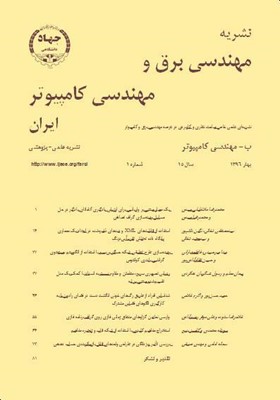استفاده از قابلیتهای XML و دیدهای ذخیرهشده در ایجاد یک معماری پایگاه داده تحلیلی تقریباً بیدرنگ
محورهای موضوعی : مهندسی برق و کامپیوترسیدمصطفی شفائی 1 , سیدمجید شفائی 2
1 - دانشگاه تربیت دبیر شهیدرجایی
2 - دانشگاه آزاد اسلامی، واحد تهران مركز
کلید واژه: پایگاه داده تحلیلی تقریباً بیدرنگ دید ذخیرهشده XML XQuery XSLT,
چکیده مقاله :
یک چالش اساسی در حوزه سكوها و کاربردها چگونگی نمایش و ترکیب نتایج به دست آمده از بخشهای بیدرنگ و ایستا و همچنین کاهش زمان پاسخدهی به پرسوجوهای پردازش تحلیلی برخط در یک پایگاه داده تحلیلی تقریباً بیدرنگ است. بنابراین محتوای مناسب میتواند از طریق ایجاد یک واسط مشترک از نتایج پرسوجوها، در یک پایگاه داده تحلیلی تقریباً بیدرنگ تولید شود. این مقاله معماریی ارائه میکند که شامل یک رویکرد واسط XML, XSLT برای تولید محتوای مناسب و همچنین ساخت دیدهای ذخیرهشده در سمت مشتری میباشد. در این معماری با فراهمکردن یک الگوی تولید خروجی مبتنی بر HTML، نحوه انتشار و ترکیب نتایج ارائه میشود. همچنین دو رویکرد موازی برای ترکیبکردن نتایج بخشهای بیدرنگ و ایستا از پایگاه داده تحلیلی تقریباً بیدرنگ برای معماری پیشنهاد میشود. در معماری ارائهشده، نقش اساسی XML و فناوریهای وابسته به آن در تولید و نگهداری محتوا در یک پایگاه داده تحلیلی تقریباً بیدرنگ مشخص میشود. نتایج آزمایشها، کاهش زمان پاسخدهی به پرسوجوهای پردازش تحلیلی برخط را از طریق دیدهای ذخیرهشده در سمت سرور و مشتری نشان میدهد. توابع سود معرفیشده برای انتخاب دیدهای ذخیرهشده در هر دو رویکرد دیدهای ذخیرهشده در سمت مشتری و سرور، باعث بهبود فضای نگهداری میشود.
A major challenge in the field of platforms and applications is how to display and combine the results of real-time and static partitions, as well as reduce the response time of on-line analytical processing queries in a near real-time data warehouse. So appropriate content in a near real-time data warehouse can be produced through a common interface for the results of queries. This article provides an architecture that includes an XML/XSLT interface approach to generate appropriate content and also creating materialized views in the client side. In this architecture, providing a model-based HTML output, distribution and composition of results, are presented. In addition, two parallel approaches for incorporating the results of real-time and static partitions of near real-time data warehouse architecture are proposed. In the proposed architecture, the fundamental role of XML and its related technologies, the production and maintenance of content in near real-time data warehouse is determined. The results show that response time of on-line analytical processing queries via materialized views in the server and client side is reduced. Introduced functions for selecting materialized views in the both of client and server sides improve the storage space.
